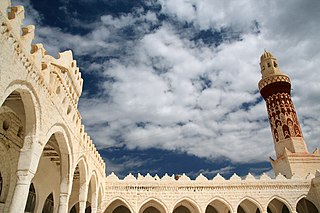Related Research Articles

Fatema Mernissi was a Moroccan feminist writer and sociologist.
Buraq Hajib, also spelt Baraq Hajib, was a Khitan who founded the Qutlugh-Khanid dynasty in the southern Persian province of Kirman the early 13th century after the conquest of the sinicised Qara Khitai by the Mongol Empire. The dynasty founded by Buraq Hajib ended in the 14th century.

Sharifa Fatima was a female Zaydi Sayyid chief in 15th century Yemen.
Princess Ghaliya or Ghaliyya Al-Badry Al-Bogami was a Saudi woman who led military resistance to prevent the Ottoman recapture of Mecca during the Wahhabi War. She was given the title Amira, which is the female version of the title Emir which means princess, in recognition of her acts.

Nasir al-Din Mahmud I (1088–1094) was an infant sultan of the Seljuk Empire from 1092 to 1094, with most power held by his mother Terken Khatun. He was a younger son of the former sultan Malik Shah I and proclaimed sultan at Baghdad by the caliph al-Muqtadi. Under his notional reign, the empire built by his father and Alp Arslan fragmented. After Mahmud's forces lost a battle at Borujerd, he and his mother were assassinated by the family of the former vizir Nizam al-Mulk.

Asma Bint Shihab al-Sulayhiyya was the queen and co-ruler of Yemen in co-regency with her cousin and spouse, Ali al-Sulayhi, and later her son Ahmad al-Mukkaram, and daughter-in-law, Arwa al-Sulayhi, from 1047 until 1087. Her full title as sovereign, "al-Sayyida al-Hurrat-ul" translates to "The noble lady who is free and independent, the woman sovereign who bows to no superior authority". As female sovereign, Asma bint Shihab has an almost unique position in history: though there were more female monarchs in the international Muslim world, Asma bint Shihab and Arwa al-Sulayhi were the only female monarchs in the Muslim Arab world to have had the khutba proclaimed in their name in the mosques as sovereigns.
Al-Sultana Khadeejah Sri Raadha Abaarana Mahaa Rehendhi or more famously known as just Rehendhi Khadeejah meaning, Queen Khadeejah, was the Sultana of the Maldives from 1347 to 1379. She was one of the few female rulers in the recorded history of Maldives.
Al-Sultana Raadhafathi Sri Suvama Abaarana Mahaa Rehendhi was the Sultana regnant of the Maldives in 1379–1383. she was also known as Myriam.
Al- Sultana Dhaain Kambaidhi Kilege Sri Nithaa Abaarana Mahaa Rehendhi, was the Sultana regnant of the Maldives from 1383 to 1388. She was also known as Fatima.
Subh, also known as Aurora in the Basque Country, or as Sobeya, Sobha, or Ṣabīḥa Malikat Qurṭuba, was the spouse of Caliph al-Hakam II of Córdoba, and the regent of the Caliphate of Córdoba in al-Andalus during the minority of her son, Caliph Hisham II.
Thumal the Qahraman was a Muslim woman appointed in 918 as a judge in a maẓālim court during the reign of Caliph al-Muqtadir. She was not a Qadi, for she only dealt with secular law. She was put in charge of rescripting the petitions which petitioners brought to the court. Her position was an extraordinary unique for her sex. She was appointed by Umm Jafar Muqtadir, the mother to caliph Jafar al-Muqtadir-billah, the eighteenth Abbasid caliph.

Safwat al-Din Khatun, otherwise known as Padishah Khatun(Persian: پادشاه خاتون), was the ruler of Kirman from 1292 until 1295 as a member of the Qutlugh-Khanid dynasty in Persia and a poet in Persian language.
Celâliye Terken Khatun was the first wife and chief consort of Malik Shah I, Sultan of the Seljuk Empire from 1072, until his death in 1092. She was born as a Karakhanid princess, the daughter of Tamghach Khan Ibrahim. She was the mother of Mahmud I, the next ruler of the Seljuk Empire, and regent during his minority in 1092–1094.
Al-hurra or al hurra was an Arabic title historically often given to, or used to refer to, women who exercised power or had a position of power or high status.
Hababah, was a jarya slave singer and poet of the Caliph Yazid II.
Shaghab was the mother of the eighteenth Abbasid caliph al-Muqtadir, and wielded a considerable influence over state affairs during the reign of her son. She was commonly referred to only as Umm al-Muqtadir or al-Sayyida.
Kutlugh Turkan, was a sovereign ruler of Kirman from 1257 until 1282.

The Mosque of Queen Arwa bint Ahmad Al-Sulayhi, or simply the Queen Arwa Mosque, is a historical mosque in Jibla, Yemen. It was built between 1056 and 1111 C.E. by Queen Arwa al-Sulayhi and her tomb had later become the site of pilgrimage. It retains its importance as one of the oldest ancient Yemeni mosques. It is also known as Hurrat-ul-Malikah Mosque, as the queen was often referred as Al-Malika Al-Hurra, which means "The Noble Queen".
Jalal ad-Din Suyurgatmish was Qutlughanid ruler of Kerman and a son of Qutb al-Din Mohammad.
Ismah Khatun was a Seljuk princess, daughter of sultan Malik Shah and principal wife of Abbasid caliph al-Mustazhir.
References
- ↑ Mernissi, Fatima; Mary Jo Lakeland (2003). The forgotten queens of Islam. Oxford University Press. ISBN 978-0-19-579868-5.
- Mernissi, Fatima; Mary Jo Lakeland (2003). The forgotten queens of Islam. Oxford University Press. ISBN 978-0-19-579868-5.